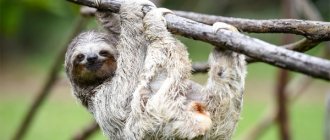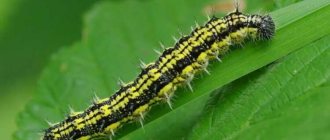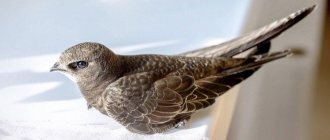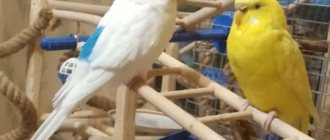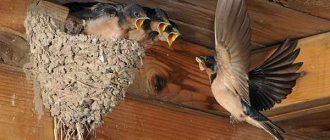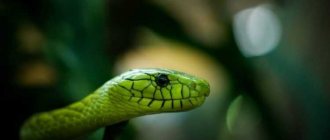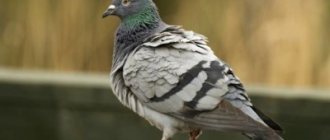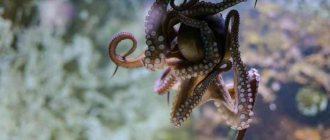The raven is a bird that easily adapts to any living conditions. This bird is distributed almost throughout the planet. The gloomy silhouette of this bird in the sky always leads to the most ridiculous thoughts. In fact, it is only now that it has become known how smart and patient this bird is. Not so long ago, the raven served as a symbol of misfortune and various phobias. The image of the raven has been transformed into the mythology of many peoples, into fiction, music and cinematography.
For many times, people have tried to tame the raven and keep it as a poultry. Despite this, the raven personifies freedom and intelligence, which is unusual for a bird. There was a time when the number of this bird began to decline, acquiring alarming levels. Fortunately, man made sure that the raven population did not decrease, so its numbers began to increase.
Appearance
— Advertising —
Photo of a gray crow
The raven's build is thin. Birds of this species have long thin legs, a cone-shaped beak, and narrow long wings. The plumage is black with a greenish or blue-violet sheen, but there are species that have white and gray colors in their color. The base of the feathers is white or gray. The tail of most subspecies is wedge-shaped, sometimes rounded. The birds' maneuverability during flight is ensured by a long tail and tail feathers. Female crows are smaller than males (the former weigh 400-450 grams, the latter weigh up to a kilogram).
The photo shows a crow and a rook
People who are far from ornithology confuse the crow with the rook and raven. Indeed, these birds look similar to each other in appearance, but in reality they are completely different birds.
— Advertising —
Difference between a rook and a crow:
- a crow is larger than a rook (the maximum weight of a crow is 1300 grams, the weight of a doctor does not exceed 650 grams);
- In the crow, the area at the base of the beak is feathered, in the rook it is not;
- with age, the rook's beak becomes lighter, while the crow's beak remains black throughout its life;
- rooks' nests are larger and deeper;
- crows are smarter than rooks;
- The lifespan of a crow is longer.
Factors that influence life expectancy
The main factors due to which the lifespan can either significantly increase or decrease:
- Predators. They are found both in urban and wild environments. Young birds can face various dangers - from kites to stray dogs and cats. Adults are already able to fight back and have enough experience to notice the danger in time and retreat.
- Living conditions. In their natural environment, birds are not always able to eat enough. They are almost always hungry, because they have to be content with small bugs, worms and seeds. But for a large bird that spends a lot of energy on flight, this is clearly not enough.
- It is believed that females live several years longer than males. This is due to the fact that the latter much more often have to enter into conflicts both with crows (for food, territory, a nest they like) and with representatives of other species (when protecting chicks and nests from attack).
- Cold winters. At this time of year, it is especially difficult to obtain food, and energy consumption increases significantly - when the temperature at night drops to -30°C and below, only the strongest birds have a chance of surviving until dawn.
People also make a certain contribution to changes in the life expectancy of ravens. Ecological deterioration, specialized poisons - all this can either shorten the time allotted to birds or end their lives at any moment.
How do ravens differ from ravens?
In the image of a Crow and a Raven
It is a mistaken belief that a raven and a crow are a female and a male of the same species of bird. The female crow is a crow, not a raven; accordingly, the crow belongs to a different category of birds. And although both birds belong to the same genus and family, and are similar in appearance, they still have many differences.
Distinctive features:
- A crow is smaller in size than a raven. The maximum weight of a crow is 1200 grams, the mass of a crow can reach two kilograms;
- The raven's tail is long, sharp, and wedge-shaped. In the crow it is shorter, often rounded at the end.
- The raven has short feathers sticking out to the sides on its neck. A crow's feathers are all smooth.
- The crow prefers a flock lifestyle. Raven always keeps to himself.
- The crow chooses the countryside as its habitat, and cities - closer to people. The raven avoids humans and prefers deserted places and rocky gorges for living.
- In flight, the crow makes frequent wing beats. Takes off from its place. The flight of a raven resembles the flight of a bird of prey. The wing beats are rare and smooth. Before taking off, the bird makes several jumps, as if running.
- The crow's voice is like clicking. Raven caws.
Types of crows, how long they live
According to the description of the crow, 9 species of birds are included in them. All of them are representatives of the genus Crow (Corvus), the Corvid family.
Age statistics
For reference! Scientists argue that there is no consistent or understandable distinction between "crows" and "crows". These terms are used in relation to various types of birds, mainly based on their size - crows are usually larger than crows.
Black Raven
One of the species of crows, with the following characteristics:
- weight - from 650 to 800 g;
- length - 40 cm;
- wingspan is from 60 to 75 cm.
The feathers are cast in an emerald hue against a general black background. The legs with a short beak are colored black. Dark bristly hairs grow on the nostrils. The bird lives in European, East Siberian, and Far Eastern territories; individual subspecies live in East Asia. There can be 17 pairs in a flock.
For reference! When asked how long a black raven lives, ornithologists answer that it is approximately up to 30 years.
Antillean raven
A little-known representative, painted black with a bluish-violet tint. The long and low-set black beak optically increases the length of the head, and the bristly feathers do not cover the nostrils.
Near the organs of vision there is bare dark gray skin, and there are similar areas at the base of the lower jaw. The iris has a reddish ocher tint, the paws have a common color.
For reference! It belongs to the four largest subspecies, grows up to 46 cm. Neighboring species include the Cuban, Jamaican and palm raven.
This raven is a bird that feeds on fruits, invertebrates, chicks and toads. Lives in Haiti and the Dominican Republic and is considered extinct.
Palm subspecies
Australian
There are 3 subspecies living in Australia, the Australian one is considered the largest:
- weight - from 650 to 700 g;
- length - 53 cm;
- wingspan - up to 100 cm.
The base of the feathers is dark grayish, the overall color is black. Features of the Australian species include a white iris; in young animals it is greyish. On the neck there are feathers with a green-blue undertone, quite long. What crows eat: mainly plant foods.
The closest relatives of the Australian representative include the Tasmanian and Bennett's crow.
For reference! The life expectancy of a raven from Australia is about 15 years.
Australian blue crow
Gray
What is a gray crow? This bird is larger in size than a rook, the body is painted steel, the rest of the body is black.
The average length is from 40 to 50 cm, weight is from 460 to 735 g. They move along a flat surface in steps, and in case of danger they jump.
The habitat is limited to Central and North-Eastern Europe, Asia and Western Siberia.
Important! How many years do hooded crows live: from 20 to 30.
White-necked Crow
It will grow up to 50 cm, has a large wedge-shaped beak, slightly smaller in size than that of representatives of the common raven. There are whitish feathers on the neck, the bird's voice is high. Prefers to gather in groups and lives in shrubby pastures and desert habitats.
Distributed in the midwestern and southeastern United States (Colorado, Arizona, New Mexico, Kansas, Oklahoma, Texas), and northern Mexico. What crows eat: preference is given to large insects, cereals, carrion, eggs, fruits, lizards, small mammals, chicks and waste.
Important! Nests are made in trees, buildings, electrical poles and abandoned cars. Each clutch contains up to 8 eggs, greenish-blue in color, interspersed with a brownish tone in the form of spots and stripes.
White-necked or collared
Nutrition
In the photo, a crow is eating bread.
Crows eat insects, worms, fish, frogs, eggs and chicks of other birds. In search of food, crows unite in flocks of 8-10 individuals. Together they hunt small birds and rodents. Crows accompany feathered predators and animals, eating up the remains of their prey. Urban crows live in landfills and feed on food waste. They choose only fresh food; if the product has spoiled, do not touch it. Village birds swarm in the manure, looking for insect larvae.
The photo shows crows feeding on dead ducks.
The diet of birds contains food of plant origin. Crows happily eat grains, seeds, fruits and vegetables.
Spreading
Area
The photo shows a crow in the city.
Crows are found in Russia, Europe and Asia, North America, North Africa, Australia.
Habitats
The photo shows a crow near the river.
Crows live in wooded areas, cities and small settlements. Sedentary species prefer to nest along rivers and lakes. In the northern regions, nests are built on rocks, rarely in trees.
Section 2. The amazing red sea urchin
These mysterious sea creatures live in the waters of the Pacific Ocean, mainly off the west coast of North America. Red sea urchins prefer quiet places on the virtually uninhabited ocean floor and usually live at a depth of at least 90 meters. Their lifespan is several centuries.
Scientists know that they all move little, are attached to the sea soil and feed mainly only on small organisms, which they swallow with water and then filter.
Modern researchers believe that echinoderms of this species are practically immortal and have no signs of aging. By the way, sea urchins, even at the age of a century, are just as fertile as their ten-year-old relatives. They can only die from disease or predators.
Indeed, a sea urchin is one that lives 300 years, and maybe longer.
Why was it called “crow”
The bird received this name because of the color of its plumage. The word “crow” was born from the word “voronoi”, which means “black”. Among the Indians, “crow” means “burnt,” that is, “black.”
In the photo there is a crow near the magazines
In Rus', the crow was called “vrana”. Linguists believe that the word comes from the consonant words “enemy”, “lies”, “enemy”.
Migratory or not
The photo shows a sedentary bird, a crow.
Crows are not migratory birds, although there are species that lead a semi-nomadic lifestyle. They are forced to fly from place to place by a lack of food or unfavorable weather conditions. They roam in large flocks of 100-300 birds. Crows do not fly further than 1000 kilometers from home.
Population and species status
A flock of crows
About 200 years ago it was believed that crows brought only misfortune to the house. The reason is that they ate all the crops in the field. The bird was constantly persecuted and exterminated with poison baits. These actions greatly reduced the number of birds.
Now there is a law prohibiting doing this. And in recent years, the raven population has begun to increase. Although the bird is still considered rare.
The main problem for the raven is the lack of food, especially in winter. In some countries, the bird population has increased thanks to tourists - the latter leave behind waste that is eaten by the birds.
Lifestyle
In the photo there is a small flock of crows
Crows lead a gregarious lifestyle. One crow family consists of 50 adult birds. The fact is that when growing up, young individuals rarely leave the family. Thus the flock grows. Crows are known to have an analytical mind and a brilliant memory. Adult birds are engaged in training their offspring.
The photo shows a flock of crows sitting on a tree
Crows walk well on the ground. They take off right away. To eat food they descend to the ground. While flying, the crow often flaps its wings. The flight is nimble and maneuverable.
Crows easily adapt to rapidly changing environmental conditions. In search of food, they settle next to human habitation, because they have plenty of food waste. Crows eat together. If someone doesn't get enough food, they share it. Although some individuals are still distinguished by greed. Having eaten, they bury the remains in the ground. However, if they see that other crows are watching her actions, they can only pretend that they buried food.
In the photo the crows are circling
Crows hold funeral services for their dead relatives. The flock circles over the dead bird, then sits down next to it and is silent.
In the photo the crow makes the sound "Carr"
Crows make sounds that humans hear as "karr". However, ornithologists note that this same “carr” has a lot of variations and is used depending on the circumstances. The tonality of sounds is determined by signs of danger, anxiety, joy, anxiety and other emotions.
Features of character and lifestyle
Photo: Raven in flight
Raven is one of the most intelligent living creatures on earth. It has been noticed that before doing anything, the raven assesses the situation quite accurately. And it works as usefully as possible, eliminating unnecessary movements. Scientists have repeatedly studied the bird's mental abilities. Experiments on intelligence led them to the conclusion that the raven has intelligence. It turned out that the bird quickly navigates the proposed complicated situation. The experiment conducted by ornithologists is well described.
The essence of the experiment was as follows. The raven was offered a rather narrow transparent vessel with water, where a delicacy in the form of worms floated. Stone pebbles were laid out nearby. The raven, who could not reach the worm, quickly realized that he could throw pebbles into the water, thereby raising the water level. In addition to the stones, there were other objects in the pile that did not sink in the water.
Raven thought of pulling them back out so they wouldn't get in the way. Thus, the bird quickly got to the treat. For the purity of the experiment, this experiment was repeated, and with other crows, and the result was the same. It has been noticed that the raven often uses improvised objects to get food.
The ability to use auxiliary means is transferred to young crows in the process of observing adults, so it cannot be called innate. The way the raven drinks also confirms his high intelligence. While most birds take water into their beaks and then raise their heads to let it drain, the raven does something different. He places his slightly open beak on the water, turning his head to the side, as a result the water itself flows into the cavity, all he can do is swallow it.
Despite its outwardly serious appearance, the raven is a very playful bird. Young crows very willingly play with various objects, hiding them after playing enough. Moreover, they can also involve other animals as objects for their fun, while observing the necessary caution.
Reproduction
The photo shows a female and a male crow.
Crows reach puberty at two years of age. Most species of crows are monogamous, but there are also those who choose a new pair for breeding each season. The mating season begins in early spring. At this time, the birds behave restlessly and noisily: they constantly circle in the air and scream loudly.
The photo shows a crow building a nest
Nests begin to be built in April-May. Dwellings are built in forest parks, on power line supports, under the eaves of houses. Steppe crows build nests in rock crevices.
In the photo, a male and female crow are building a nest
The nest is built by both future parents. Housing is assembled from twigs and sticks. To make the frame strong, the wood is bonded with clay and damp turf. The bottom is covered with down, cotton wool and dry grass. Nest dimensions: diameter - 50 centimeters, depth - 20-25 centimeters, wall thickness - 2-4 centimeters.
The photo shows the eggs of a gray crow
On average there are 3-6 eggs in a clutch, less often 5-8. The color of the shell is dirty blue with numerous brown inclusions. The female incubates the chicks for three weeks. All this time, the male feeds his wife and protects the territory from predators. The cubs are born unfeathered, with red skin. By the month, dark gray sparse fluff appears. By the beginning of summer, the chicks begin to fly. At this time, crows learn to fly, and the chicks often fall out of the nest. If this happens, then under no circumstances should the little crow be picked up, otherwise the parents will abandon him. Adult birds carefully watch the chicks and if one of them ends up on the ground, they try to help the baby.
The photo shows crow chicks
By mid-summer, the young leave the parental nest, but family ties remain for many years. Until the next season, the former chicks will live next to their parents. There are cases when past offspring helped parents feed the current one.
Section 4. Bowhead whale
The bowhead whale is dark in color and lacks a dorsal fin. The length of this giant mammal can reach 20 meters and weight – 100 tons.
Unlike other whales that migrate to other places to breed, the bowhead whale lives only in arctic and subarctic waters. Unfortunately, these days the number of these giants has greatly decreased, and they are certainly in danger.
One of the articles by University of Alaska scientist Ned Rozelle describes a whale over 210 years old. True, it should be noted that the accuracy of the method used to determine the age range was only 16%, which means there is a huge probability that this animal could be 177-245 years old.
These studies show that the bowhead whale is one of the oldest mammals on the planet, although in the media, as a rule, there is information that among the permanent inhabitants of the water depths, turtles live for 300 years, and for all other representatives of the underwater kingdom this is simply impossible . Worth thinking...
Keeping crows at home
The photo shows a crow chick at home.
It is impossible to tame adult crows to life in captivity. But chicks that find themselves with a person quickly get used to their owner and consider the person both father and mother. Constantly being near a person develops the crow's ability to speak. Birds enjoy imitating the voice and speech of domestic animals and humans.
The photo shows a crow at home
Crows are kept in large mesh enclosures. A branched snag is installed inside or a bush is planted - a place where the bird will eventually build a nest. During the mating season, one male is placed with the female.
In the photo there is a gray crow at the table
Captive crows are fed food of animal and plant origin. Grains, vegetables and fruits are alternated with insects, meat, and fish. Poultry eats rabbits, beef, mice and lizards. Pork and sweets should not be given to crows. It is also strictly forbidden to add salt to food. Don't forget about vitamin complexes and fermented milk products.
At home, crows feel comfortable. Sometimes they are kept outside the cage - tamed birds are unlikely to fly away from the yard. The life expectancy of poultry increases by 2-2.5 times.
Pictured is a Hoodie Crow at home
When getting a pet, keep in mind that crows are unclean birds. There will be plenty of dirt from them. It is better to cover the floor in the enclosure with a covering that will be easy to clean later. Use linoleum or metal sheet. Cover the top of the canvas with fresh sawdust.
Crows suffer from parasitic insects that settle on the skin and between the feathers of the bird, causing infections. To prevent the bird from suffering, the bird should be bathed periodically. Crows enjoy water treatments, so a vessel with clean water is installed indoors, which the bird will use as a bath.
Hoodie chick at home
Birds vitally need movement. When the crow gets used to its new home, it needs to be released from the enclosure to “spread its wings.” The bird must be in the air for at least two hours a day.
Appearance and description
The raven (Corvus corax) is the largest representative of the corvid family; it has a massive, compact body with tightly pressed plumage and a large, thick neck. The bird has a powerful, long beak, curved at the top, shaped like a cone. The feathers in the throat area are arranged like a fan and move when the raven makes sounds. These features serve as a distinctive feature of the genus.
The plumage of males and females is the same, there are no obvious sexual differences. The color depends on the species; it can be completely black, with white patches, or with shades of brown or cream.
Raven appearance
Raven appearance
Raven appearance
Raven appearance
Raven appearance
The bird's wings are quite long, narrowed, with a span of about 1.5 m. Movement is rare compared to other members of the family, the flight style is similar to that of an eagle, the raven can also soar for a long time in the air flow.
The paws are large, the claws are sharp, black, and protect against enemies. The raven also uses them to attack small rodents. The eyes are round, large relative to the size of the head, the iris is dark brown, with a reddish tint or light blue.
The raven makes abrupt loud sounds. The timbre is low, alarming - because of this feature, in popular beliefs it is considered a harbinger of trouble. Only during the mating season do males sing drawn-out songs with periodic guttural clicking.
Interesting Facts
- The crow is a smart bird. To crack the nut and eat the contents, the bird will not break the shell with its beak, but will throw it under the wheels of a car.
- Crows love to have fun by riding down slides in winter, teasing cats and dogs.
- The bird will first soak a stale piece of bread in water.
- Crows imitate the voices of animals and people.
- Crows live in different parts of the planet. They feel comfortable in Siberia, Africa, and Europe.
- Crows are friends with each other. If trouble happens to a bird, its brethren will not abandon it.
- Crows are vindictive. If someone has offended them, they can take revenge even many years after the incident.
- When migrating, birds fly around those places where many relatives have previously died.
- Crows use twigs to get worms from under tree bark. In this way, they protect their beak from damage.
- Crows communicate with each other not only by voice, but also by gestures using their beaks.
Lifespan
In the wild, crows live 13-15 years. The life expectancy of nomadic species is reduced to 10-12 years. When kept at home, crows can live up to 40 and even 50 years. There have been cases when a feathered pet lived to be 70 years old. If the raven's conditions are incorrect, it will live much shorter.
An unbalanced diet can lead to obesity or rickets. The bird quickly dies from its painful condition.
Signs and superstitions about ravens
Ravens are considered mystical birds. It is believed that these are messengers of evil spirits, mediators between worlds, harbingers of trouble. In ancient times, people believed that if a crow sat on a person’s shoulder, he would soon die. And if an ominous bird flies into the house, then the family will not escape trouble.
The image of a black crow is often found in art and world folklore. In fairy tales, legends and tales, the bird personifies evil spirits and death. It is not for nothing that in fairy tales, where a bloody battle took place, a flock of crows immediately appears. The birds croak ominously, circle over the corpses, and peck out the eyes of dead soldiers.
In many world cultures, the crow is credited with fantastic abilities. In India, it has long been believed that birds can contact the souls of dead people. In Ancient Greece, these birds were considered messengers of the gods. The Greeks believed that the crow could heal a person not only physically, but also spiritually.
Not all signs and superstitions regarding crows are negative. The image of a crow also symbolizes wisdom, intelligence, and prosperity.
Signs:
Folk signs about the crow
- a crow sits on a burnt tree - unfortunately;
- one crow feeds another - to good luck and joy;
- a crow sat on the roof of a house - wealth awaits the family that lives in it;
- birds are circling over the house - a child will be born here soon;
- a crow croaks loudly and looks at the water - it means rain;
- a crow has flown into the window, croaks loudly and flies around the rooms - one of the household members will become very ill;
- to kill a crow is to commit a grave sin. Misfortune awaits a person;
- a crow sits on the roof of a church - someone will die soon;
- a flock of crows leaves the forest - to hunger, death, war.
Why do you dream about a crow:
Why do you dream about a crow?
- a dream in which a crow croaks means that a person is in mortal danger. Salvation will come in prayers;
- a flock of crows circling overhead in the sky - to war, death;
- crows sitting in the field - the year will be lean;
- in a dream, a crow builds a nest - to a massive loss of livestock.
Intelligence and acumen
Raven solving a puzzle
The proportional relationship between the body and the volume of the brain in a bird is the same as in primates. According to ornithologists who observed the behavior of the raven, it has intelligence and memory, which is passed on to the next generation. Quickly adapts to external factors, learns throughout life.
A simple experiment speaks about intellectual abilities, for example, if you offer a crow two bowls of food, he will choose where there is more of it. Confirmation that adults adapt to technological progress, taking advantage of the situation, is evidenced by very unusual behavior. The bird throws nuts under the wheels of the car, when the shell cracks, it pecks at the kernels.
Interesting fact : the raven is able to solve a logical problem that most three-year-old children cannot do. Keeping a bird at home for a long time develops the ability to imitate human speech. The vocabulary can include up to 1000 short words.
Crow's voice
Crows have developed vocal cords. The bird's voice is similar to laughter - just as booming and loud. The timbre is high. The sounds are mostly unvoiced, the “words” end in consonants. Ornithologists have found that birds use different tones to signal their relatives. During mating games, crows scream a lot. At this time, the voice is melodic and bubbly. During the nesting period, sounds become short and muffled. A monologue consists of several short words separated by 1-2 second pauses. If ravens have drawn-out sounds, then the ravens shout short syllables “krrykh”, “kyrkh”, “collapse”, “krykh”. Birds make sounds more like clicking and crackling.
Section 6. Giant turtle
Long-lived reptiles include giant Seychelles tortoises, which are famous for their longevity. Their life expectancy is on average 100-150 years. Of course, they cannot be classified as those who actually live 300 years, but, according to the research of modern scientists, one of such representatives of the mentioned species was the Advaita tortoise, which surpassed all its relatives and lived for more than 250 years.
Advaita spent the last century of her existence in captivity in the Calcutta Zoo, where she died at a fairly old age. Even the lack of a natural habitat and limited space, which in most cases tend to have a detrimental effect on animals, did not affect the turtle’s lifespan.



